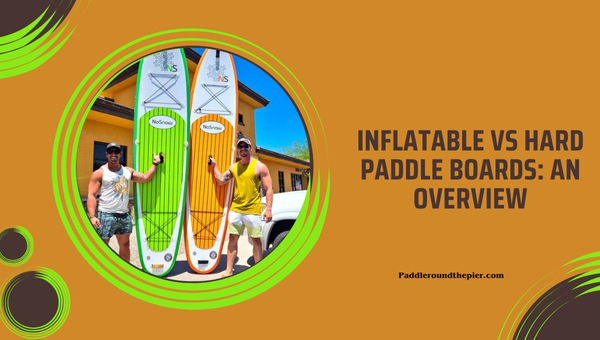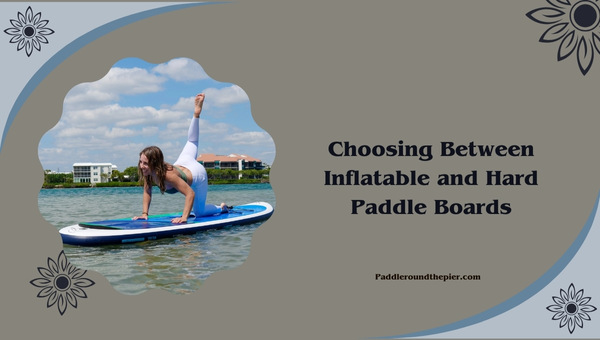A Comprehensive Guide: Inflatable vs Hard Paddle Boards
The age-old battle of inflatable vs hard paddle boards is a topic that's been heatedly debated among paddle board enthusiasts for years. As an avid paddler myself, I understand just how challenging it can be to decide between the convenient portability of an inflatable board and the unmatchable performance of a hardboard. It can feel overwhelming, especially when there's no shortage of opinions and recommendations buzzing around on the internet.
Spending my time cruising both types of boards allowed me to bring to light some critical things about them that most folks might easily overlook. Whether you are venturing into paddle boarding for the first time or preparing for a gear upgrade - getting your facts straight on the inflatable vs hard paddle boards tussle will guide you in choosing your perfect aquatic companion.
What You'll Get From Here
- Unbiased comparison between inflatable and hard paddle boards
- In-depth understanding of their manufacturing processes
- Key considerations when choosing between these two types
- A potential answer to your burning question: "Inflatable or hardboard, which should I buy?"
Inflatable vs Hard Paddle Boards: An Overview
As an avid paddleboard enthusiast, I've often been asked about inflatable and hard paddle boards. They may seem pretty similar at first, but when you dig deeper, you'll find each has its unique characteristics and perks. I'm all geared up to give you a peek into my world, so let's dive right in!

- Inflatable Paddle Boards: They're exactly what they sound like – paddle boards that you can inflate. Picture a giant balloon shaped perfectly for me to stand on while gliding over the water surface! What makes it appealing?
- Portability
- Easy storage
- Affordable
- Hard Paddle Boards: These are traditional, rigid boards usually made of foam, fiberglass or epoxy – giving them durability but also heftiness:
- Greater speed
- Superior stability
- Ideal for tracking
To put the 'inflatable vs hard paddle boards' debate into context, imagine this scenario: I love traveling light and my regular vacations lead me straight into Mother Nature’s lap, where lakes or sea shores often feature in the itinerary. That's where an inflatable paddle board becomes my go-to companion with its lightweight charm.
On another page, if I’m setting out on a weekend for sheer thrill and adventure with friends – hoping to cut through waves at notable speeds – the robust make of hard paddle boards becomes my trusty aide.
Picturing it already? Now, let's take our understanding of these two distinct kinds up a notch.
Inflatable Paddle Boards
Now, let's dive into the world of inflatable paddle boards. As someone who's stood on quite a few, I can tell you there's more to these boards than meets the eye.
The Making of Inflatable Paddle Boards
Inflatable paddle boards, or iSUPs, as they're often referred to, are made from strong, durable materials like PVC and high-density drop-stitch fabric. The design process involves:
- Layers of PVC are heat-bonded around a core made from thousands of tiny polyester threads - this is known as drop-stitch technology.
- Then, the board gets its shape through high-pressure inflation.
- Additional layers reinforce key areas such as rails and deck for improved durability.
This construction method results in inflatable paddle boards that are light but incredibly resilient - perfect for withstanding impacts and bending without breaking.
The Pros of Using Inflatable Paddle Boards
So why might you choose an inflatable paddle board over a hard one?
- Portability: Unlike hard paddle boards that require roof racks for transportation, iSUPs deflate and pack down into a backpack or carry bag. Their portability makes them great for travel or hiking to secluded paddling spots.
- Durability: Despite what you might think, inflatables can be remarkably tough - capable of bouncing off rocks where hardboards might scrape or crack.
- Cost-efficient: Generally speaking, inflatable boards are more affordable than their rigid counterparts, making them appealing for beginners or budget-conscious paddlers.
Don't get me wrong here; hard paddle boards have their merits, too - which we'll discuss shortly in this "inflatable vs hard paddle boards" comparison!
The Cons of Inflatable Paddle Boards
Of course, there are always drawbacks when it comes to choosing gear:
- Speed: Hardboards typically outpace inflatables due to their streamlined shape and rigid construction.
- Inflation time: It can take 5-10 minutes to inflate an iSUP, depending on the pump used - not a deal-breaker, but something to keep in mind.
- Stiffness: Despite impressive advancements in inflatable technology, hard paddle boards still offer superior rigidity – which can be especially noticeable when riding waves or during intense paddling sessions.
The "inflatable vs hard paddle boards" dilemma isn't clear-cut as both have their own unique strengths and weaknesses. Yet that's what makes the choice so fascinating!
Hard Paddle Boards
When it comes to the inflatable vs hard paddle boards debate, it's essential to understand what sets hard boards apart.
The Construction of Hard Paddle Boards
The first thing to note is how these devices are made. Unlike their inflatable counterparts, hard paddle boards are typically crafted from high-quality materials such as fiberglass and foam cores. Some even feature a wood veneer layer for that classic surfboard look.
Here's a quick glance at what goes into creating one:
- Foam Core: At the heart of every hard board, you'll find a foam core that gives these pieces their buoyancy and shape.
- Fiberglass Layer: Wrapped around this foam core is the fiberglass layer that offers an extra level of durability.
- Epoxy Resin Outer Coat: Finally, the entire rig is coated in epoxy resin for added resistance to watery elements.
The Advantages of Hard Paddle Boards
Choosing between inflatable and hard paddle boards often boils down to understanding each one's benefits. Here are some reasons you might favor hard paddle boards:
- Speed: Due to their rigid construction and sleek design, they cut through water much faster than most inflatables.
- Agility: If you're into maneuvers or surfing waves with your board, then a hard board provides the required agility because of its excellent displacement function.
- Stability: Since they don't give inflatables under pressure, they offer superior balance on water.
Against an inflatable board counterpart, if speed or surfing ability is crucial for your SUP fun times on water bodies, then clearly, the points lean towards choosing a solid-built board.
The Disadvantages of Hard Paddle Boards
Despite these advantages, there are a few points where choosing between inflatable vs hard paddle boards can tilt in favor of inflatables due to certain drawbacks:
- Costly: Built with advanced materials, it means higher costs upfront than inflatable boards.
- Storage and Transportation: Their bulky nature demands dedicated storage space and specialized racks for transportation.
- Durability: While they are durable in water, a collision with rocks or other hard surfaces can easily damage them.
The point is not to dishearten any buyers. Like all things in life, it boils down to what you prioritize - budget, speed, versatility or convenience. Reflect upon these aspects before you decide on the right fit for your paddle-boarding experience.
Choosing Between Inflatable and Hard Paddle Boards
The choice between inflatable and hard paddle boards often boils down to factors such as transport, storage space, your usage preferences, and budget. To make the best decision, it's crucial to consider these aspects thoroughly.

Considerations for Choosing the Right Board
When it comes time to decide between inflatable vs hard paddle boards:
- Transport means: Consider how you'll be transporting your paddle board. If you frequent distant water bodies requiring long drives or flights, inflatable boards with their superior portability, turn out a good choice. On the other hand, if your adventures are near home or a short drive away and have a car roof rack or truck bed ready to go, a hard board could work excellently.
- Storage Space: Evaluate where you'll likely store your board. An inflatable board can be deflated and fit comfortably in small spaces like closets or under the bed. However, if you have ample space in a garage or dedicated sports equipment room - storing a solid hard pad wouldn't pose much of an issue.
- Usage preferences: It's all about what feels right beneath your feet on water. Some feel more content on more rigid surfaces only provided by hard boards while others value resilience over rigidity which most inflatable boards well succeed at.
- Budget boundaries: Hanging onto that wallet tighter? More often than not, Inflatables tend to be lighter on pockets than their harder counterparts regarding upfront costs.
Remember! The ideal option isn't necessarily what works best for everyone else - rather one that aligns most suitably with personal preferences & practicality.
Making The Decision: Inflatable vs Hard Paddle Boards
After considering individual wants & needs in light of the points above:
Go Inflatable If:
- Frequent Transport: You're often on the move with your paddle board.
- Limited Storage: You're short on storage space.
- On a Budget: You're looking for a cost-effective option while ensuring durability.
Choose Hard If:
- Minimal Transport: Your paddling spots are closer to home, and you’ve got means to transport.
- Ample Storage: You've got space to store a hard board properly.
- Speed & Surfing Perks: You're more into speedy gliding or high-performance wave riding.
Consider these aspects based on priorities and circumstances, and you'll naturally gravitate towards the best fit - be it the flexibility of inflatables or the constancy of hard paddle boards in your adventuring endeavors. Remember, there's no definitive right or wrong choice here - instead, an informed one that should serve your needs best on those much-loved waters!
Conclusion
Choosing between inflatable and hard paddle boards ultimately hinges on your unique preferences, paddling habits, and logistical constraints. That said, it's clear each type has its own set of perks. Even though hard paddle boards excel in speed and performance and engage well with waves, making them surfer-favored, they require dedicated storage space and aren't easy to carry around. On the flip side, inflatable boards are budget-friendly, easy to store and transport – acting as a boon for travelers or space-constrained individuals – but may lack rigidity when it comes to navigating rough waters.
Key Takeaway Points
- Inflatable paddle boards are portable and budget-friendly with compromises on speed.
- Hard paddle boards offer superior performance but lack portability.
- Factors such as storage capacity, transportation methodology, and individual needs must influence your decision in the hard vs inflatable paddle board debate.
